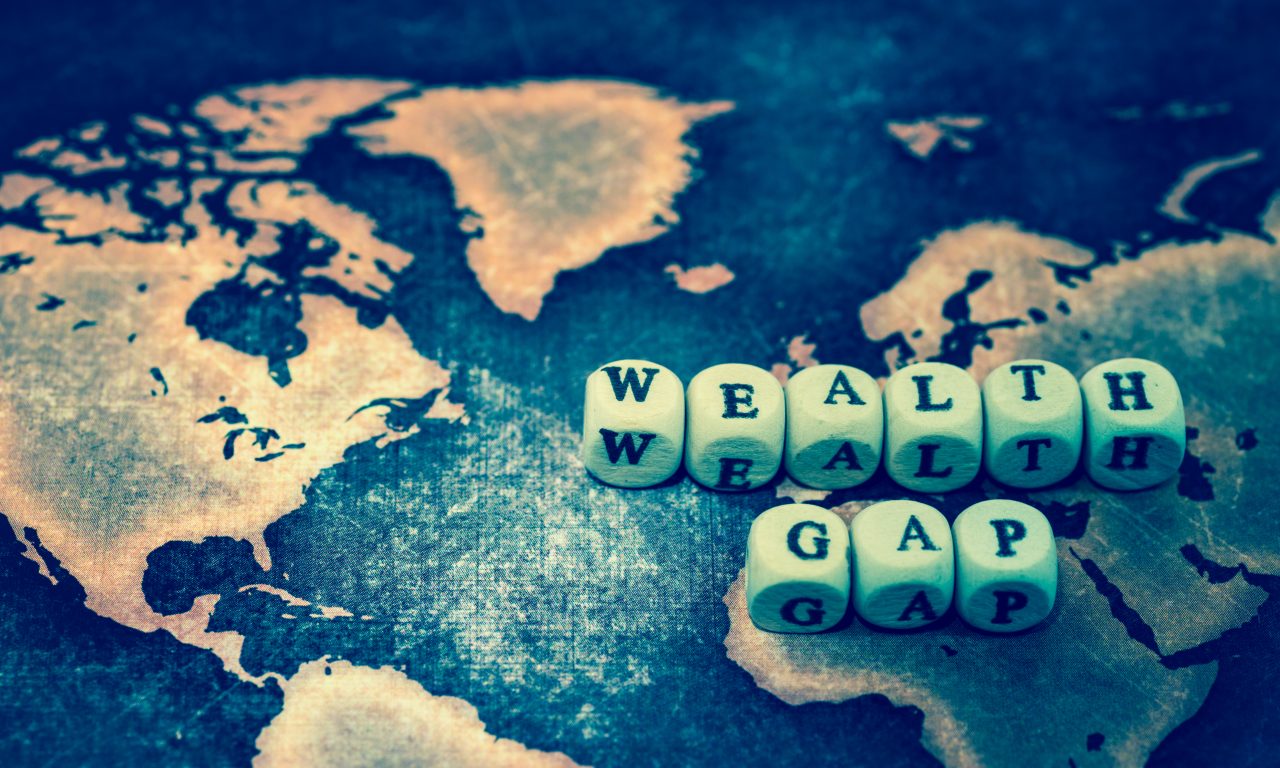A foremost issue of catastrophic economic proportions is the mounting wealth gap in America. According to the Pew Research Center and CNN Business, as of 2016, upper-income families had 75 times the wealth of lower-income families. Stated another way, according to a Washington Post article, the notorious American “One-Percent” owns approximately 40% of the nation’s wealth.
Before I go any further into this critical topic, let’s get an understanding of terms that will be used throughout this article—wealth, household income, median household income, lower, middle, and upper-income. Wealth (or net worth) is essentially the market value of your assets minus debts. Household income refers to the combined gross income of all members of a household, defined as a group of people living together, who are 15 years or older. Median household income refers to the income level earned by a given household where half of the homes in the area earn more, and half earn less. Concerning lower, middle, and upper-income households, according to the Pew Research Center, as of 2016, lower-income households had incomes less than $45,200, whereas upper-income households had incomes higher than $135,600. In contrast, middle-income households (approximately 52% of the U.S. population) had incomes ranging from about $45,200 to $135,600.
If average Black family wealth continues to grow at the same pace it has over the past three decades, it will take Black families 228 years to amass the amount of wealth White families have today. Institute for Policy Studies, 2016
Among the wealthy nations of the world, the United States stands out for its wealth inequality in that it owns a much larger share of the country’s wealth than the 1% elsewhere. Moreover, the median wealth of American upper-income families (approximately $810,000 as of 2016—that’s a 10% gain post the Great Recession of 2007-2009), is at the highest level since the Federal Reserve started collecting these data in 1983.
Featured articles
Caring for Natural Hair: Tips for Queens with Tight Curls & Coils
supermodelsociety.org https://supermodelsociety.org/wp-content/uploads/2025/03/cropped-Updated-Logo.png
1809
668
https://supermodelsociety.org/wp-content/uploads/2023/02/Hair-Care-article-pic-1-950x1024.jpg
800
862
https://supermodelsociety.org/wp-content/uploads/2025/03/cropped-Updated-Logo.png
1809
668
https://supermodelsociety.org/wp-content/uploads/2023/02/Hair-Care-article-pic-1-950x1024.jpg
800
862
Fragrance Guide: Picking the Right Scent For You
supermodelsociety.org <img src="https://supermodelsociety.org/wp-content/uploads/2025/03/cropped-Updated-Logo.png" alt="Fragrance Guide: Picking the Right Scent For You"/> https://supermodelsociety.org/wp-content/uploads/2025/03/cropped-Updated-Logo.png 1809 668 https://supermodelsociety.org/wp-content/uploads/2021/07/Fragrance-1024x683.jpeg 800 534Understanding Blockchain Technology & Its Investment Potential
supermodelsociety.org <img src="https://supermodelsociety.org/wp-content/uploads/2025/03/cropped-Updated-Logo.png" alt="Understanding Blockchain Technology & Its Investment Potential"/> https://supermodelsociety.org/wp-content/uploads/2025/03/cropped-Updated-Logo.png 1809 668 https://supermodelsociety.org/wp-content/uploads/2021/04/blockchain2-1024x512.jpeg 800 400At no surprise, these gaps in wealth are even starker across racial/ethnic lines—which is most pronounced between White households and so-called Black or African American as well as Latinx households. The Great Recession drove wealth inequality in America to the highest levels recorded. Post-Great Recession, as of 2016, the median wealth of White households was $171,000. That’s 10 times the wealth of Black households ($17,100)—a larger gap than in 2007—and eight times that of Hispanic households ($20,600), about the same gap as in 2007.
 When getting into the weeds of the data, from 2007 to 2016, as pointed by the Pew Research Center, the gap between “lower-income White households” and “lower-income African American and Latinx households” decreased by close to 50%. However, among middle-class families, it increased and shows no sign of retreating. In the Pew Research report, How wealth inequality has changed in the U.S. since the Great Recession, by race, ethnicity, and income, it is noted:
When getting into the weeds of the data, from 2007 to 2016, as pointed by the Pew Research Center, the gap between “lower-income White households” and “lower-income African American and Latinx households” decreased by close to 50%. However, among middle-class families, it increased and shows no sign of retreating. In the Pew Research report, How wealth inequality has changed in the U.S. since the Great Recession, by race, ethnicity, and income, it is noted:
“Middle-income Black and Hispanic families took a substantial hit in the recession. The median wealth of middle-income Blacks fell to $33,600 in 2013, down 47% from 2007. Likewise, the median wealth of middle- income Hispanics dropped to $38,900 in 2013, a loss of 55% since 2007. Meanwhile, middle-income White families experienced a less substantial loss of 31% in this period, as their median wealth fell to $131,900. As a result, racial and ethnic wealth inequality among middle-income families increased during or after the recession. From 2007 to 2013, among those in the middle-income tier, the White-to-Black wealth ratio increased from three-to-one to four-to-one, and the White-to-Hispanic wealth ratio increased from two-to-one to three-to-one.”
Extreme wealth inequality is bad for a nation’s economy. In fact, the Organization for Economic Cooperation and Development(OECD)—an organization that represents some of the wealthiest nations on the planet (the U.S. included), noted that wealth inequality knocked nearly five percentage points off economic growth in 19 OECD countries between 1985 and 2005.
It’s important to note that there is a persistent Black-White wealth gap—regardless of marital status, income, age, and even educational attainment—all of which are factors that are typically associated with rising wealth. In a 2018 report by the Center for American Progress (CAP), Systematic Inequality: How America’s Structural Racism Helped Create the Black-White Wealth Gap, the researchers contend that “Blacks who have higher education levels, are married households, and obtain higher incomes still acquire significantly less wealth than Whites who lack those qualifications.” For example, when comparing wealth between African Americans who have attained a college degree to that of Whites without a degree, on average, African Americans still make about 30% less.
For those who believe that “personal finance choices” are the primary reasons why African Americans have less wealth, I would caution from such an assumption. In a recent Duke University Study, Race and Consumption: Black and White Disparities in Household Spending, a study which looked at specific categories of spending, the researchers note, “for clothing, jewelry, personal care, entertainment, eating out, and other non-essential spending, our findings show that Black consumers, in fact, spend the same or much less than Whites, at all income levels.” The only category in which African American households were found to consistently spend more was for utilities.
Pointing to data from 2013 and 2014 Consumer Expenditure Surveys, in their report, The Asset Value of Whiteness: Understanding the Racial Wealth Gap, researchers found that the average White household spends 1.3 times more than the average African American household. And yes, family structure, income, occupation, geography, and home ownership, were taken into account when coming up with that figure.
Taking into consideration everything that has been discussed, what are the key factors that have contributed to racial wealth inequality here in the U.S.—particularly between Blacks and Whites? At no surprise, the long-term impact of U.S. chattel slavery; deeply rooted institutionalized racism; employment discrimination; high denial rates when applying for credit (which is often used to acquire real estate and fund business ventures); targeted mass incarceration; and the overall systematic breakdown of African American nuclear families (to name a few) have been the major contributors to this vicious cycle of extreme wealth inequality. These factors have consistently impeded, and many times have inhibited, African Americans from having access to opportunities that realize economic success.
At a most basic level, vital wealth-building instruments are home ownership, having other private investments, and owning a business. Even though these are pillars of wealth, time and time again, African Americans have had to traverse through intentionally designed obstacles that have served as barriers to acquiring, maintaining, and obtaining returns from assets that often translate into real wealth. In an Institute for Policy Studies report, Dreams Deferred: How Enriching the 1% Widens the Racial Wealth Divide, it is asserted that the median Black family is on track to reach zero wealth by 2082. Although this report paints a bleak picture on the economic future for African Americans, I am convinced that ALL IS NOT LOST! African Americans are a very talented, resourceful, and exceptional group of people. I firmly believe that through collective wealth-building efforts (e.g., acquiring real estate, investing in stocks and cryptocurrencies, gold and silver, and establishing and supporting Black-owned businesses), African Americans can and will work as a unified body to turn the economic-tide (in the right direction) for our people and future generations.
On economic prosperity central to entrepreneurship, in their report, The Tapestry of Black Business Ownership in America: Untapped Opportunities for Success, (a report funded by the W.K. Kellogg Foundation), the Association for Enterprise Opportunity (AEO) found that the gap in average wealth between Black and White adults decreases from a multiplier of 13 to 3 when you compare the wealth of business owners by race. Now that’s impressive! All the more reason why African Americans must be intentional and diligent about developing and supporting Black-owned businesses. In future posts, we’ll delve deeper into the power of entrepreneurship and how it translates into economic power for the African American and African diaspora overall.






Comments are closed